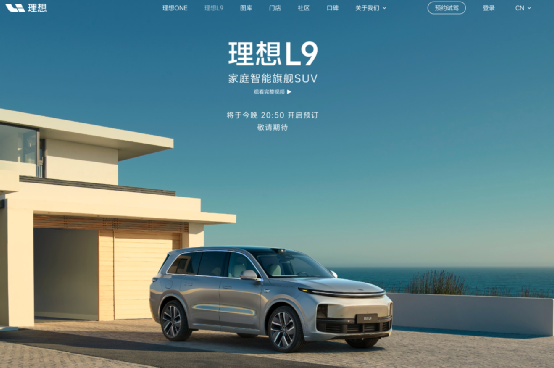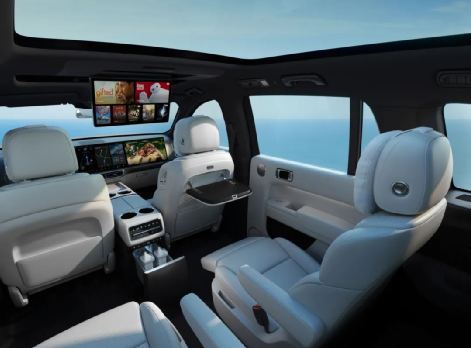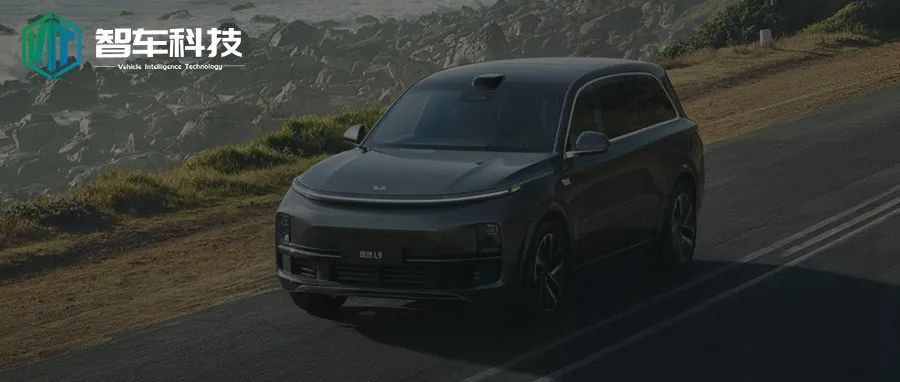Foreword
The original plan for the Ideal L9 was to release on April 16th, but as we all know, the epidemic is hard to avoid. Finally, the day has come, and tonight, the Ideal L9 will be presented in front of us. On June 4th, Li Xiang, the founder, chairman, and CEO of Ideal Automotive, revealed some important information about the Ideal L9: it will be officially released on June 21st; all stores nationwide will be able to test drive in July; officially delivered to users in August; and the delivery volume is expected to exceed 10,000 in September. Li Xiang also stated that the Ideal L9 is the “best flagship SUV for under 5 million yuan.”
Using the phrase “有容乃大 [yǒu róng nǎi dà]” to describe the Ideal L9 is not an overstatement. In addition to the “L,” there are some selling points worth mentioning. Here, we will discuss where the new ideas of the Ideal L9 are in the following paragraphs: “Keep it brief,” “Can’t ignore,” “Must mention,” and “Talk more.”
Keep it brief: Still cool and generous
The Chinese people like things that are grand, and the pursuit of “grandeur” can be said to be ingrained in our bones. Being a high-ranking official, living in a big house, eating a big meal, using a big-screen phone…when it comes to buying a car, we naturally also pursue “big space.” Therefore, as long as we have the money, we all want to buy an extended “L.” “L” stands for “Long,” which means not only “long” but also “long-lasting.”
So what about “9”? Nine is for the extreme of the odd numbers and symbolizes “long-lasting.” It often represents the maximum or limit, such as the phrase “九霄云外 [jiǔ xiāo yún wài]” and “一言九鼎 [yī yán jiǔ dǐng],” which means supreme numbers.
 The Ideal Way to Name a New Car: Realistic and Artistic
The Ideal Way to Name a New Car: Realistic and Artistic
In 2018, Ideal ONE was not well received by the public due to its narrow range of products and lack of high-end technology as a new energy brand. Although equipped with range-extended technology, its three-cylinder engine and 35% thermal efficiency caused shaking and unsatisfactory fuel consumption when running on gasoline.
Now, Ideal L9 has replaced the old three-cylinder engine with a 1.5T four-cylinder engine, improving its thermal efficiency to 40%, which is comparable to that of Honda’s Earth Dreams and Guangzhou Honda Lingpai Rui and Yage Rui hybrid car engines.
The second car model of Ideal is also range-extended, which reminds people of Ideal’s car strategy of developing pure electric vehicles without giving up range-extended vehicles. As CEO Li Xiang said, Ideal is not unwilling to make electric cars, but is waiting for the rapid development of fast charging technology and the gradual increase in the penetration rate of charging stations.
According to Ideal’s 2030 development plan, two pure electric vehicle platforms, Whale and Shark, will be launched before 2025, both of which are high-voltage pure electric platforms. High voltage means faster charging speed, which is indeed the future development direction. However, is it a bit tight to break the curse of no pure electric vehicles in three years?
In any case, Ideal ONE has always topped the list of sales for new energy brands, proving that it hits the core needs of consumers. Therefore, Ideal did not turn the second model into a car, but still chose to develop a large-sized SUV with a larger body size.
Some say that a lifetime owning a large off-road SUV such as the Cadillac Escalade, with a wheelbase of 3302mm, body size of 5697/2045/1880mm, and a price tag of around 1.5 million, is enough. In comparison, the Ideal L9 has a length, width, height and wheelbase of 5200/1998/1800mm and 3100mm, respectively. The increasing numbers in BBA (the abbreviation of Mercedes-Benz, BMW, and Audi) represents higher luxury, and 9 is the top figure for ideal, while its price is only one-third of the Cadillac Escalade.
Lastly, let’s not overlook the smart features of Ideal cars. As intelligent technology continues to change the world we live in, cars are no exception. The most important criterion that distinguishes traditional cars from smart cars is intelligence.Although Ideall L9 has not gained the same reputation as the Cadillac Cadillac, nor has it yet delivered the promised pure electric vehicle, it has dedicated its efforts to smart technology.
Ideall L9 has not adopted the same triple-screen structure as Ideall ONE. Instead, it replaced the front LCD instrument panel in front of the driver with a large HUD, which displays a wealth of information including speed, navigation, and entertainment.

The central screen, the co-pilot’s entertainment screen, and the rear cabin entertainment screen are all 15.7-inch car-grade OLED screens with a resolution of up to 3K and an extremely high color reproduction accuracy. Behind these screens is a powerful vehicle system, which is equipped with two Qualcomm Snapdragon 8155 chips. These chips provide powerful computing power for AI, software, and entertainment and support the switching of dual 5G mobile network operators to ensure real-time online high-speed network.
Snapdragon 8155 is one of the top-level car chips in the industry at present, which is built with mature and balanced 7nm technology regarding power consumption performance; the GPU frequency reaches 700MHz and there is also an NPU with a running frequency of 900MHz, which supports 4-way video input and output.
In Ideall’s words: “Ideall L9 has opened a new era of ‘three-dimensional space interaction.’ With six microphones and three-dimensional time-of-flight sensors in the vehicle and Ideall’s self-developed multi-modal three-dimensional space interaction technology based on deep learning, passengers can interact in the most natural way possible in the car. Children who just started going to kindergarten, grandparents in their seventies and eighties, and even great-grandparents can all easily enjoy the smart experience of Ideall L9.”
This means that passengers can control entertainment, air conditioning, and other functions with gestures in the air, which is something that no other car on the market can do, and it is worth looking forward to.
In addition, Ideall L9’s flagship sound system uses a 7.3.4 panoramic sound layout with seven groups of speakers surrounding the entire vehicle, three subwoofers forming a low-frequency matrix, and four top speakers forming a sky environment. The Dolby panoramic sound technology comes with a 4D immersive audiovisual system, creating an immersive audiovisual experience in the vehicle.
It must be said: perception for safety
The era of intelligent driving assistance is approaching, and it should not only do simple things but should complete difficult and correct things. It should provide an intelligent driving experience that is both safe and easy to use without carefully examining the usage conditions all along. Of course, all of this is based on safety.
The Ideal L9 features the fully self-developed flagship intelligent driving system AD Max, which takes advantage of perception, decision-making, planning, and control software to ensure system reliability and high growth potential. The AEB automatic emergency braking function has been optimized for Chinese road conditions, enhances the recognition of pedestrians and bicycles crossing the road, and can effectively reduce the occurrence of traffic accidents. The full-stack self-developed capabilities can also achieve rapid iteration.
The perception of Ideal L9 mainly comes from high-performance cameras, including six 8-million-pixel cameras and five 2-million-pixel cameras, achieving a 360-degree all-round perception of the surroundings and long distances of the vehicle. Among them, the combination of two 8-million-pixel cameras facing forward can recognize vehicles, pedestrians, cones, and other objects within 120 degrees wide angle range and farthest of 550 meters.
The newly launched Ideal ONE in 2021 was the world’s first mass-produced 8-million-pixel car camera model. This time Ideal L9 is also following suit. The application scenarios of 8-million-pixel car cameras include full view (front, side, and rear), surround view, electronic rearview mirror camera, and cabin camera.
At present, the mainstream application scenario for 8-million-pixel camera is the vehicle’s front view. This is because the front view requires more complicated recognition tasks, such as identifying traffic signals and road signs, which requires support from high-pixel cameras. The requirements for other angles are relatively low, and the tasks of recognizing target objects are also relatively simple. Cameras with pixel range of 200-500 are mainly used for this purpose.
The forward-facing car-grade LiDAR is equipped with 128 lasers, and the global resolution is 1200×128, achieving 1.53 million points per second, making it the highest comprehensive performance in mass-produced car-grade LiDARs.The ideal intelligent driving computing platform for L9 includes two NVIDIA Orin-X processors, achieving a total computing power of 508 TOPS. The dual processors are redundant for each other to ensure the stability of the intelligent driving system. In terms of safety, the power system, steering system, braking system, and computing platform power supply system for the L9 have also been redundantly designed to ensure the reliability of the executive agencies. By making the previously million-level autonomous driving sensors and computing platforms standard, the L9 will achieve full-scenario navigation-assisted driving functions.
The unique intelligent driving interaction system created by L9 makes intelligent driving safer and more convenient. When the intelligent driving is started, the safety driving interactive screen and HUD will provide the most important environmental and warning information. Thanks to the high-performance camera, LiDAR, and powerful image processing capabilities, the intelligent driving information display on the center console will also be more abundant and accurate.
Inside the car, L9 adopts a brand-new capacitive sensing steering wheel and a fatigue and attention reminder system to ensure the driver’s proper use of the intelligent driving functions. The driver’s electrically pre-tightened seat belt can provide more direct tactile feedback when necessary. Outside the car, L9 is equipped with five intelligent driving auxiliary lights to indicate the intelligent driving work status to pedestrians and vehicles outside the car. The flagship intelligent driving assistant system should ensure the safety of the vehicle while also transmitting accurate information to other traffic participants.
A few more words: The LiDAR
Due to its active emission and direct 3D ranging capabilities, the LiDAR can effectively supplement the camera in many scenarios, further improving the safety of the system. For example, in scenarios where the camera is limited by low light or strong light, the LiDAR is less affected, which can ensure the accuracy of the system’s perception of the environment. Moreover, it can also help the vehicle improve its recognition of stationary and irregular obstacles, such as stationary vehicles and construction barriers on highways, to make the system’s perception of the environment more accurate.
There are several core indicators of the LiDAR worth noting. In fact, when judging the performance of the LiDAR, users mainly have three indicators: ranging capability, global resolution, and point cloud quantity.
The ranging capability refers to the distance that each beam of the LiDAR can measure with a single point of laser light, with the industry standard measuring the farthest distance on a 10% reflective surface.
The global resolution refers to the density of point cloud perception formed by the system within a full viewing field, which can be understood as “1080p” or “8 million pixels” of the camera.
The point cloud quantity combines refresh rate and resolution, referring to the number of laser beams the LiDAR can emit per unit time. The more point cloud quantity, the higher the system’s perception of the environment’s “refresh rate” at the same time as ensuring the resolution, which would react faster.The ideal range of L9 LiDAR reaches 200 meters (with 10% reflectivity) with a global resolution of 1200×128, and a point cloud quantity of 1.53 million points per second. It is the most powerful LiDAR for production vehicles in terms of overall performance. This excellent performance, which is truly 128 lines, is realized through the advanced system architecture of the L9 LiDAR and the independent integration of all 128 lasers.
All these lasers are integrated in the L9 LiDAR, which is installed on the roof of Ideal’s vehicles. The L9 LiDAR adopts the solid-state one-dimensional scanning mirror LiDAR solution – the Velodyne™ AT128 LiDAR. The internal 128 lasers are capable of vertically emitting 128 laser beams simultaneously for scanning. With a refresh rate of 1.53 million points in three-dimensional space, the AT128 LiDAR achieves excellent environmental perception.
In order to ensure a safer driving experience, Ideal L9 chooses detection distance and precision as the primary parameters in selecting LiDAR products. The AT128 LiDAR is able to detect objects up to 200 meters away with 10% reflectivity and up to 70 meters on the farthest ground line. Additionally, the AT128 LiDAR boasts a point frequency exceeding 1.53 million points per second in terms of resolution and accuracy, which breaks the point frequency record of the same type of long-range solid-state product.
The number of lasers determines the amount of laser beams that the LiDAR can emit. A higher number of lasers allows for higher resolution, which enhances the system’s perception of details in distant objects and provides a higher margin of safety. Even if one laser fails, the impact on the overall perception is minimal and driving safety is still guaranteed.
Of course, the more lasers the LiDAR has, the higher the cost. Usually, increasing the number of lasers can improve the LiDAR’s sensing effect. However, vehicle LiDAR is a balance between performance, reliability, and cost, and many automakers and LiDAR companies may choose architectures with fewer lasers.In addition, the barrier for the design and manufacture of multi-laser LiDAR is extremely high. Without strong technical strength and experience, it is impossible to integrate hundreds of lasers into a compact “chip-scale” LiDAR to ensure that the radar has a small size and ultra-high performance.
The chip-scale technology also solves the problem of large size and unattractiveness of traditional high-performance LiDAR. Heesai AT128 has a small and thin appearance. For mass-produced car manufacturers, its installation location and design scheme are very flexible, and it can be easily embedded in the body of the car and seamlessly integrated into the overall exterior design of the vehicle.
In summary, compared with the Ideal One, the ideal flagship model not only has made further progress in the aspect of L9 body, but also made advanced autonomous driving sensors and computing platforms a standard configuration, combined with self-developed software algorithms, to achieve full-scenario navigation and assisted driving functions, bringing consumers a full-size SUV full of sense of science and technology.
This article is a translation by ChatGPT of a Chinese report from 42HOW. If you have any questions about it, please email bd@42how.com.
